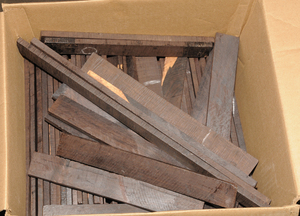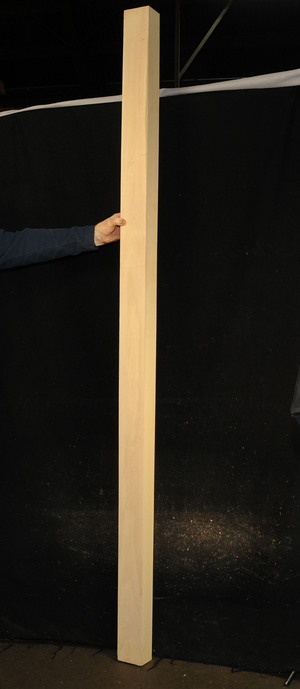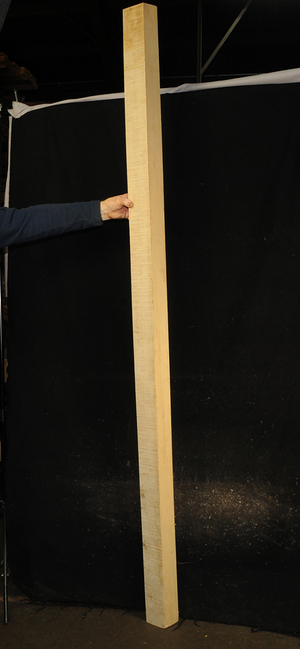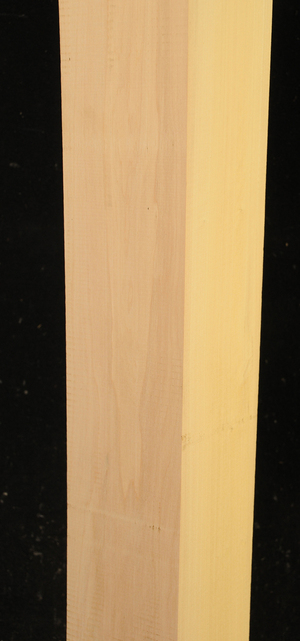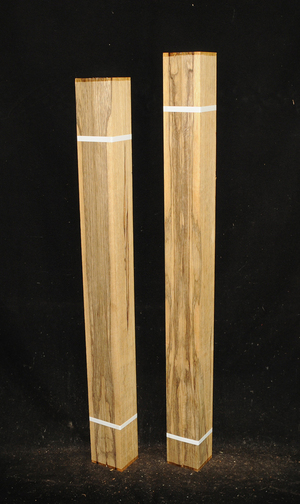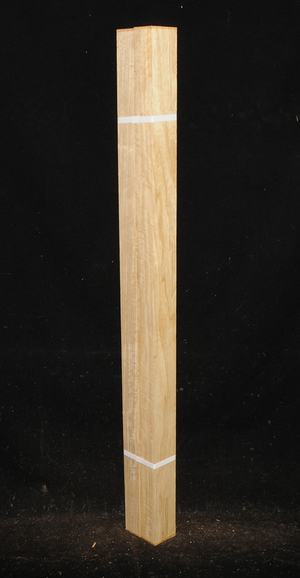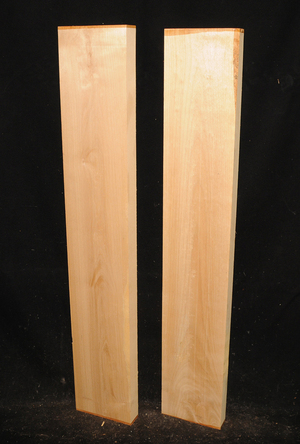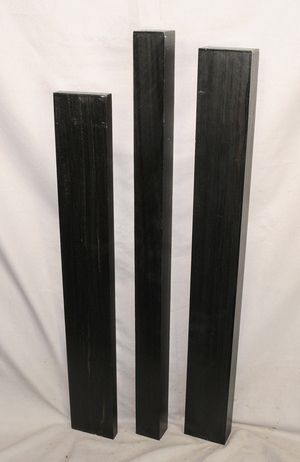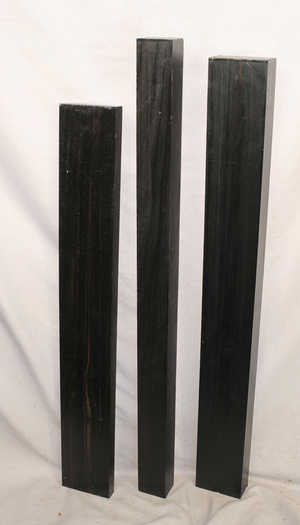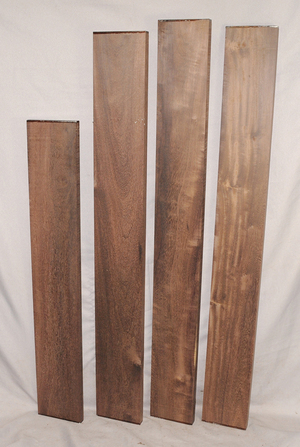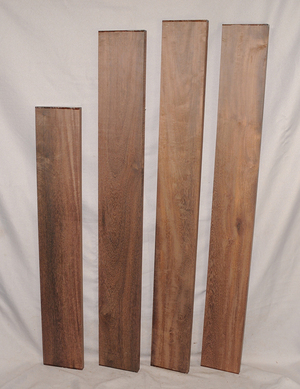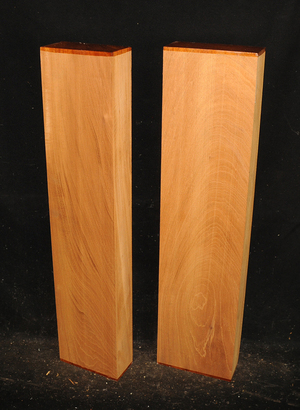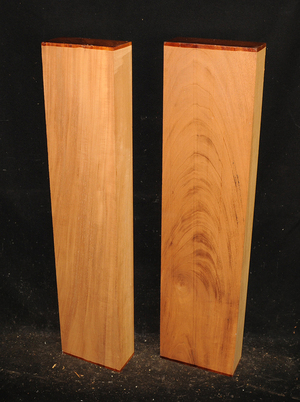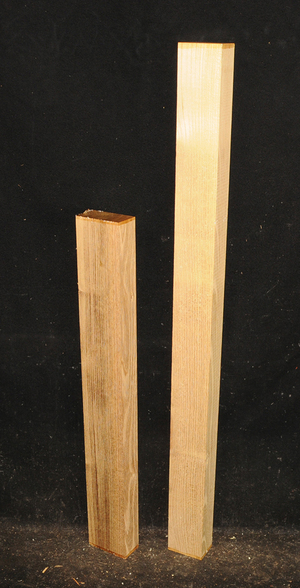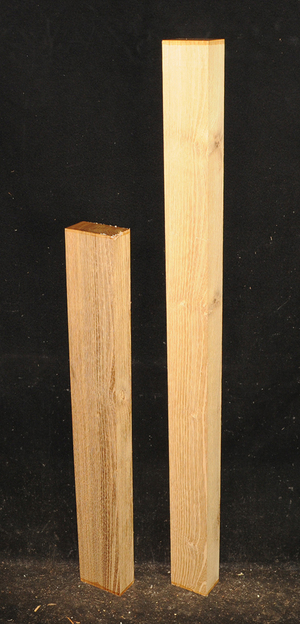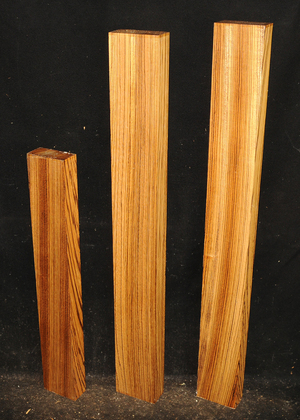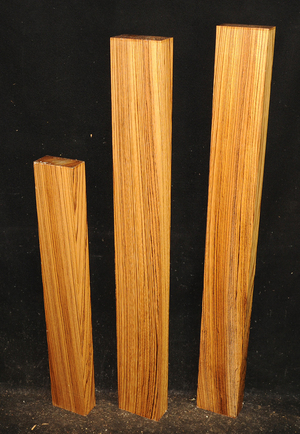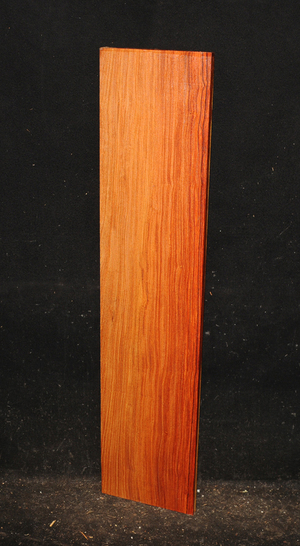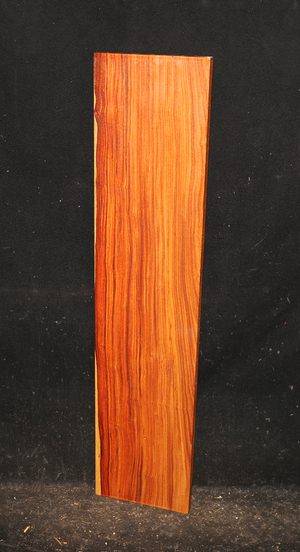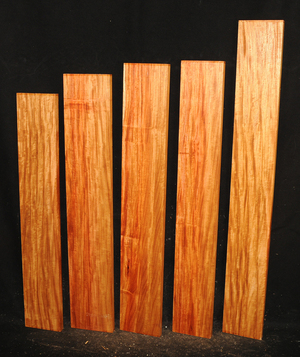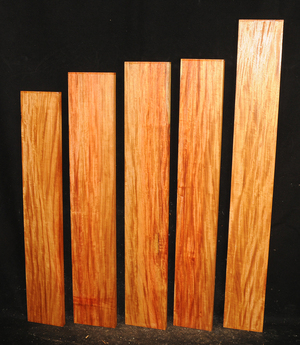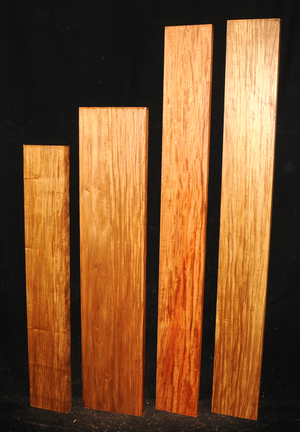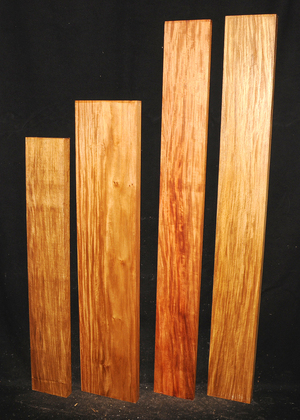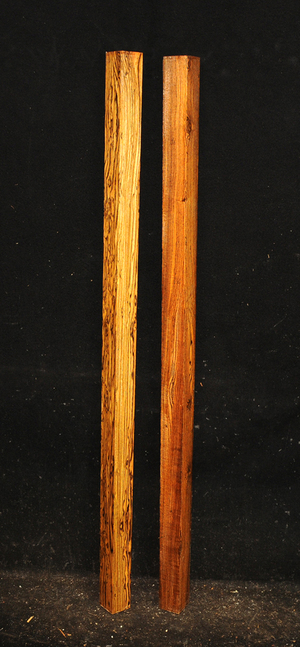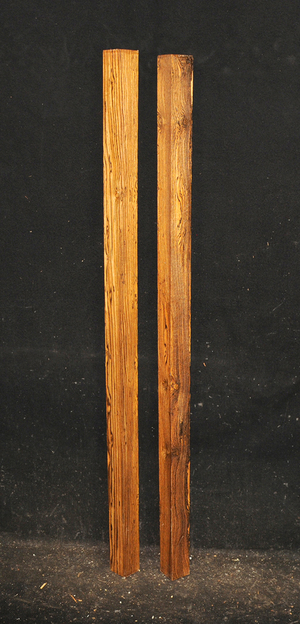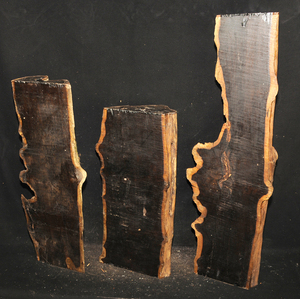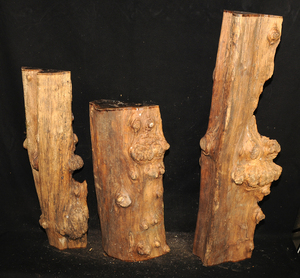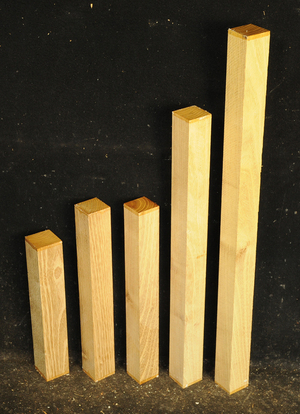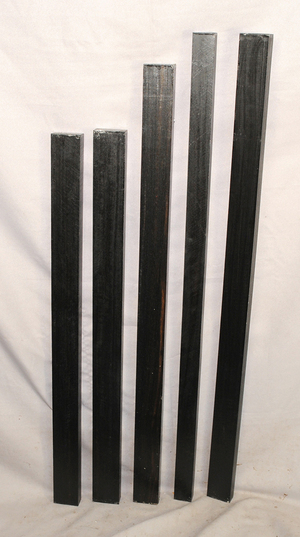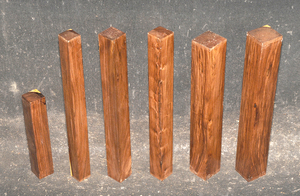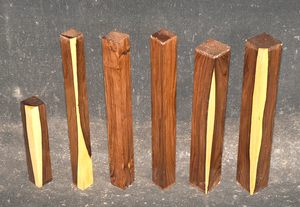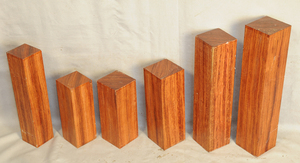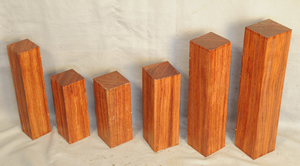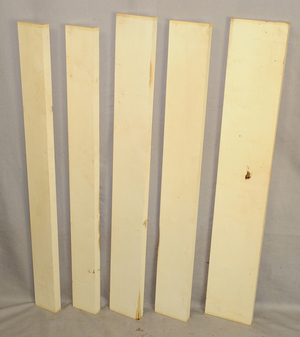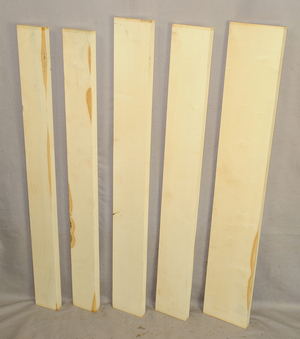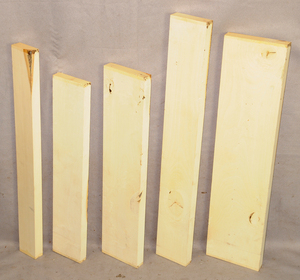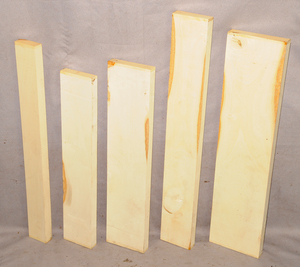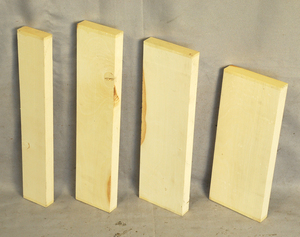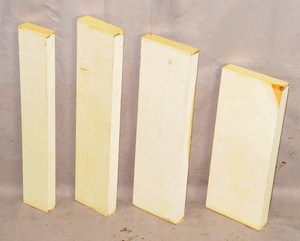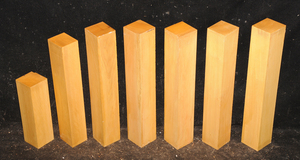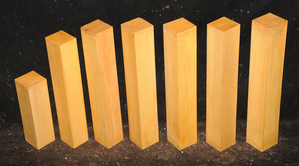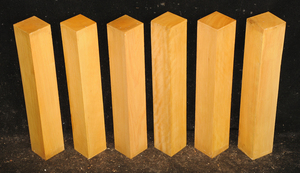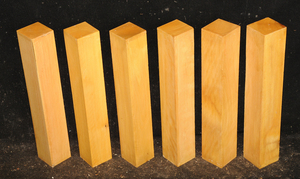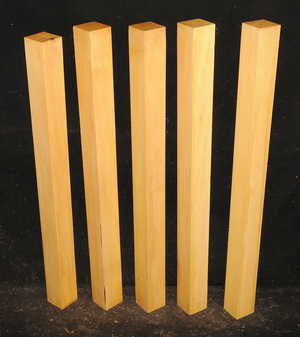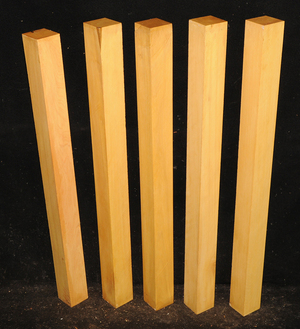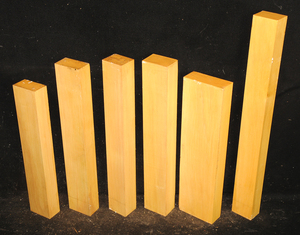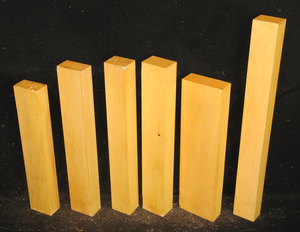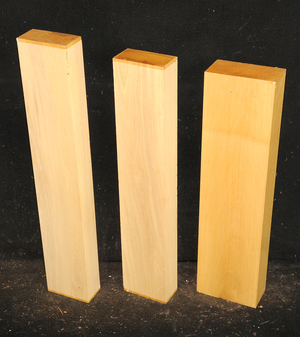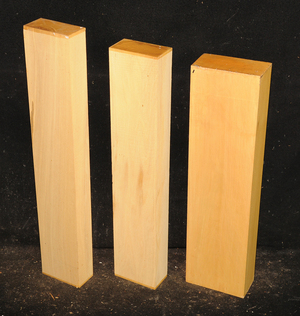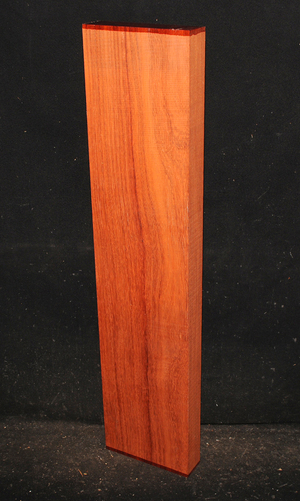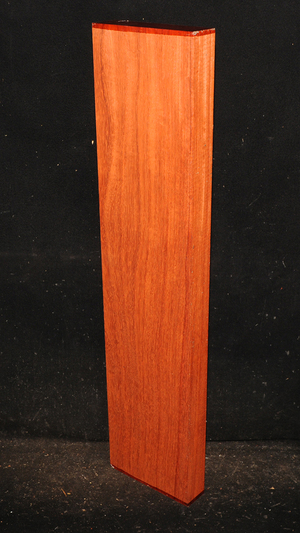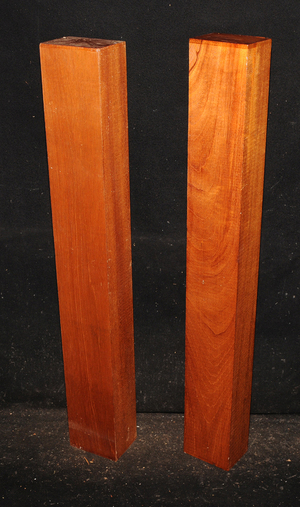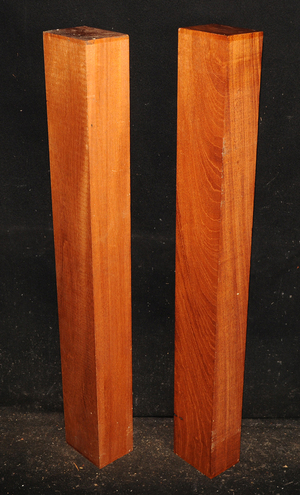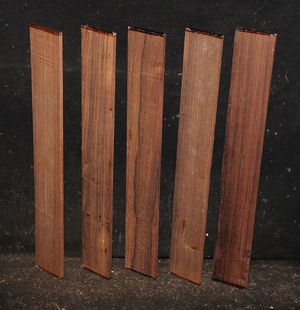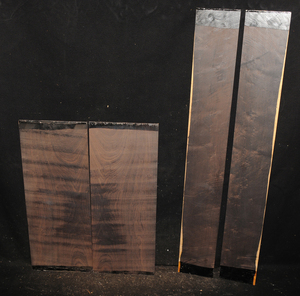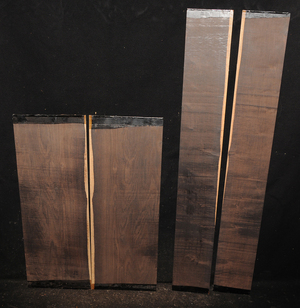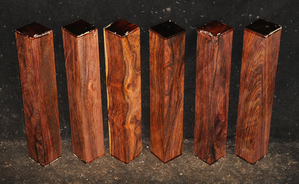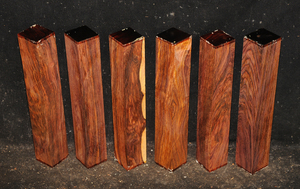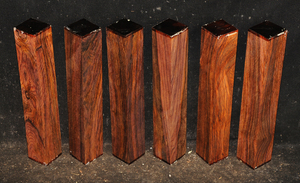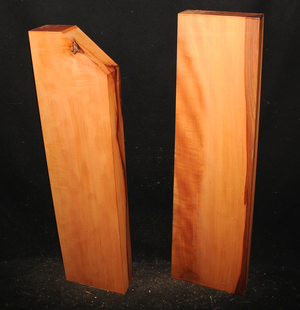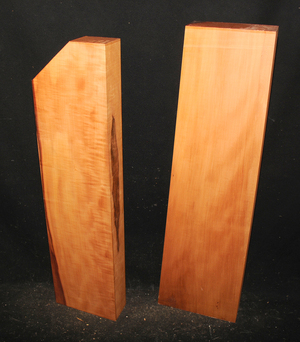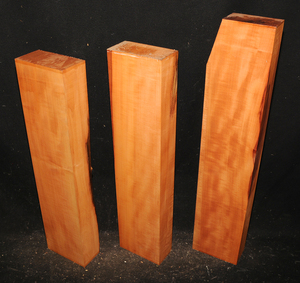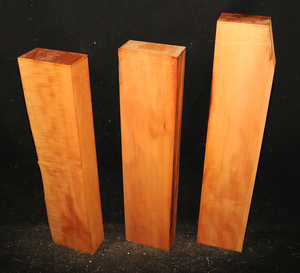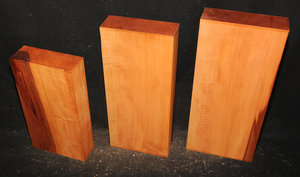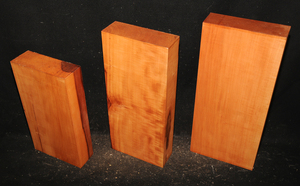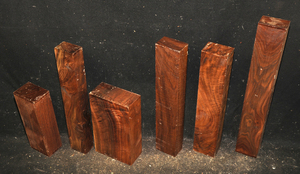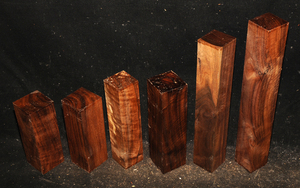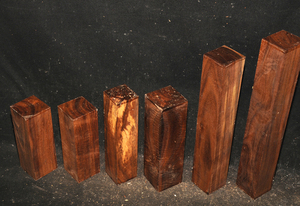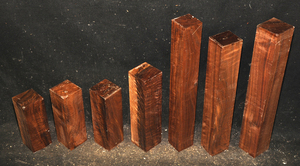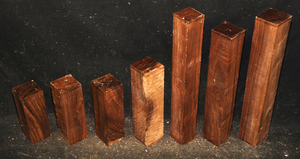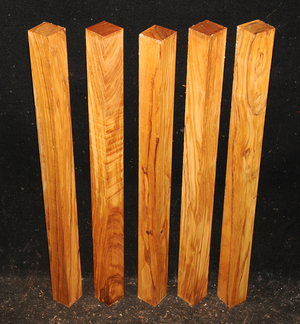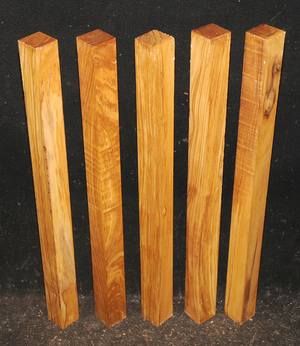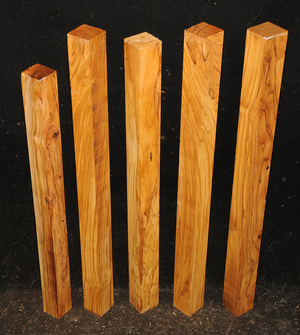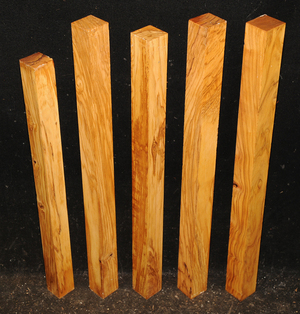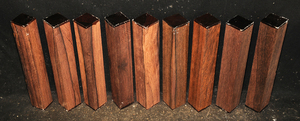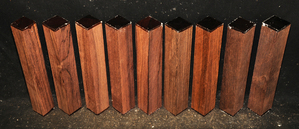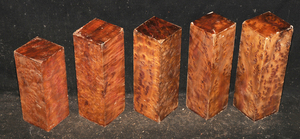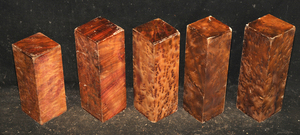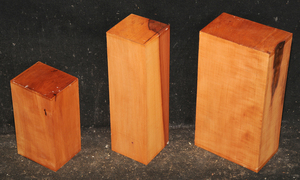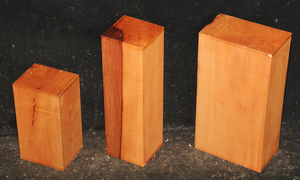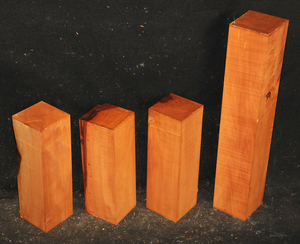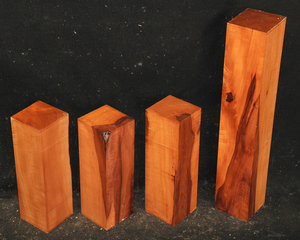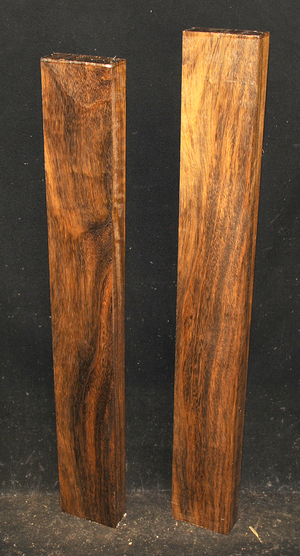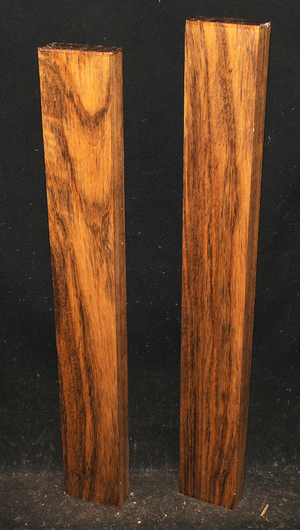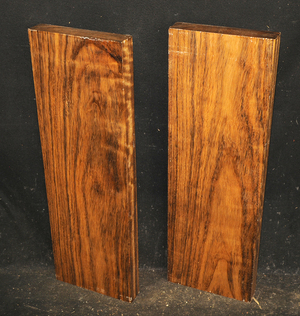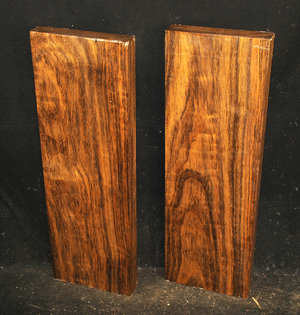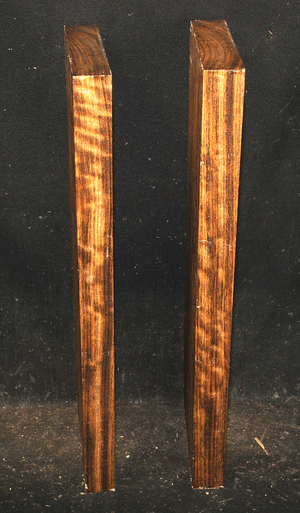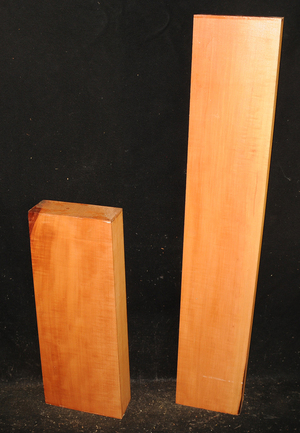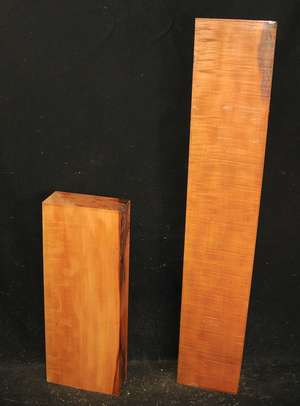African Blackwood Thins Box
Dalbergia melanoxylon
The heartwood is purplish to brownish-black with dark gray streaks giving an overall impression of being black. Lustrous with an attractive inner chatoyance. Very hard, heavy, close-grained, and virtually free from pores. Its stability and lovely tonal qualities make it an excellent instrument wood.
Due to CITES regulations, we can only ship this species to customers in the United States.
108 pieces.
Item Number: SP3708
Castello Boxwood/Lemonwood Archery Bow Blank
Calycophyllum multiflorum
Castello Boxwood, though not a true Buxus species, still has a very fine texture and a lovely light canary yellow color. This is truly a dream wood to mill.It is an excellent turnery wood, capable of very fine detail. Also very popular for making scale timbers and other parts for model ships. Air-dried.
Item Number: W43608
Black Limba 2 piece Guitar Neck Sets
Terminalia superba
Beautifully variegated and colored, Black Limba is easy to work and finish. This wood is found in the equatorial forests of West Africa. Black Limba has wonderful tonal properties and is suitable for both solid-body guitars and acoustic guitars. Easy to work and takes a nice polish.
Item Number: IW37157
Figured White Limba 2 piece Guitar Neck Through the Body Set
Terminalia superba
Also known in the guitar trade as Korina. This is a fairly lightweight, light-colored wood from West Africa with excellent tonal qualities. Occasional logs have a dark colored heart which produces what we call Black Limba.
Item Number: IW37156
Pacific Alder Instrument Billets
Alnus rubra
Hand-picked and color and grain matched.
Item Number: IW37155
West African Ebony Instrument Billets
Diospyros crassiflora
Sometimes called Gabon or Gaboon, this Ebony is sometimes jet black but oftentimes has grayish streaks that mostly disappear when finished or after the made object has been put into service. This Ebony has a marked resistance to checking that is characteristic of some of the Indian and Asian species. It has a wonderful texture and is easily carved, planed, turned, and milled. It is fairly fine-grained and takes a high polish. This Ebony usually originates in either Cameroon or Nigeria and the logs are rough hewn in the forest and oftentimes brought to the nearest road by human porters. With the disappearance of other species of black Ebony this species is fast becoming the Ebony of choice.
Item Number: IW37154
Katalox
Swartzia cubensis
This is a large tree 2-4' diameter, by up to 120' tall from Mexico & Central America. The wood is very dense and fairly fine-grained. Because of its hardness it can be difficult to work but it takes a fine polish. Its dark color leads some to call it Mexican Ebano and very dark pieces can be used as a substitute for true black Ebony, especially in laminations and inlays. Straight-grained wood can be used for musical instrument fingerboards and bridge blanks.
Item Number: W43607
Genuine Mahogany
Swietenia macrophylla
Also called Acajou, Tropical American Mahogany, and Honduras Mahogany. This medium to large tree occurs throughout Central and South America. Related to Cuban Mahogany (Swietenia mahogani) and Pacific Coast Mahogany (Swietenia humilis). It produces one of the classic furniture and cabinetmaking woods. The heartwood varies from a light reddish-brown to a rich, dark red. Generally straight grained and exceptionally stable, it is easy to machine, hand plane, sand and finish. Occasional logs produce several figures, curly, quilted, and the rare plum pudding figure which looks like large drips running down the board. Used in fine furniture and joinery, boat building, and in the guitar industry for acoustic sets and necks.
Due to CITES regulations, we can only ship this species to customers in the United States.
Item Number: W43606
Black Locust
Item Number: W43605
Zebrawood
Microberlinia brazzavillensis
This striped wood develops a beautiful golden patina as it ages.
Item Number: W43604
Pau Rosa
Swartzia fistuloides
Hard & heavy & capable of a beautiful polish. Rare on the American market. Partially air dried.
Item Number: W43603
Figured Narra
Pterocarpus indicus
Also called New Guinea Rosewood. It is a beautiful, highly lustrous golden yellow color sometimes with reddish streaks. A nice turning wood it is also used in furniture, jewelry boxes, handles, etc. It is easy to work and glue and takes a nice polish.
Item Number: W43602
Figured Narra
Pterocarpus indicus
Also called New Guinea Rosewood. It is a beautiful, highly lustrous golden yellow color sometimes with reddish streaks. A nice turning wood it is also used in furniture, jewelry boxes, handles, etc. It is easy to work and glue and takes a nice polish.
A & D have bee's-wing figure.
Item Number: W43601
Mexican Bocote Cane Blanks
Cordia elaeagnoides
Bocote is an oily wood with a yellowish to dark brown color accented with irregular black stripes and streaks. It has a spicy smell and is hard, heavy and strong. It is easy to work and takes a very nice polish. This beautiful wood is seldom seen in woodworker's shops.
Item Number: W43600
Burly African Blackwood Log Sections
Dalbergia melanoxylon
The heartwood is purplish to brownish-black with dark gray streaks giving an overall impression of being black. Lustrous with an attractive inner chatoyance. Very hard, heavy, close-grained, and virtually free from pores. Its stability and lovely tonal qualities make it an excellent instrument wood.
These have burly clusters.
Due to CITES regulations, we can only ship this species to customers in the United States.
Item Number: W43599
Black Locust Turning Squares
Item Number: W43598
Black Locust Turning Squares
Item Number: W43597
West African Ebony Guitar Binding Billets
Diospyros crassiflora
Sometimes called Gabon or Gaboon, this Ebony is sometimes jet black but oftentimes has grayish streaks that mostly disappear when finished or after the made object has been put into service. This Ebony has a marked resistance to checking that is characteristic of some of the Indian and Asian species. It has a wonderful texture and is easily carved, planed, turned, and milled. It is fairly fine-grained and takes a high polish. This Ebony usually originates in either Cameroon or Nigeria and the logs are rough hewn in the forest and oftentimes brought to the nearest road by human porters. With the disappearance of other species of black Ebony this species is fast becoming the Ebony of choice.
Item Number: IW37153
Cocuswood Turning Squares
Brya ebenus
This extremely rare species is found in Cuba, Jamaica, and the Dominican Republic. Also called Green, Brown, or West Indian Ebony. The heartwood is brownish-yellow to dark brown often with a greenish tinge. It is usually beautifully veined with darker streaks. The wood is hard and heavy weighing 68 to 80 lbs/cubic foot. This high density contributes to its wonderful acoustic properties-it fairly rings when struck. It is well known for its use in woodwinds such as flutes, piccolos, and bagpipes because of its fine and uniform grain, its beautiful coloring and its resonance.
C the actual length is 12 but we tallied it at 8 3/8 because of slight defects on one end.
F has a small defect on 2 corners that looks to go through the middle of the square.. You will for sure get 2 pieces that are clear that are 4 1/4" and 6 1/2" long. The actual length is 11 11/16". Priced according to the clear sections.
Item Number: W43609
Bubinga Turning Squares
Guibourtia tessmannii
Called by some woodworkers African Rosewood, Bubinga is a deep, lustrous, brownish-red color with a fine, darker striping. The figure makes the wood doubly beautiful. It is very hard and heavy and takes a glassy, smooth finish.
Due to CITES regulations, we can only ship this species to customers in the United States.
Item Number: W43596
American Holly
Ilex opaca
Holly is the whitest wood commercially available. Our stock was cut during the winter and quickly dried in a vacuum kiln to prevent discoloration. The result is very white wood without gray or bluish staining. The wood is fine-grained and is excellent for turnery, inlays, musical instrument edge bandings, etc. The grade is common and better which means that there can be some defects, mainly knots.
Item Number: W43595
American Holly
Ilex opaca
Holly is the whitest wood commercially available. Our stock was cut during the winter and quickly dried in a vacuum kiln to prevent discoloration. The result is very white wood without gray or bluish staining. The wood is fine-grained and is excellent for turnery, inlays, musical instrument edge bandings, etc. The grade is common and better which means that there can be some defects, mainly knots.
Item Number: W43594
American Holly
Ilex opaca
Holly is the whitest wood commercially available. Our stock was cut during the winter and quickly dried in a vacuum kiln to prevent discoloration. The result is very white wood without gray or bluish staining. The wood is fine-grained and is excellent for turnery, inlays, musical instrument edge bandings, etc. The grade is common and better which means that there can be some defects, mainly knots.
Item Number: W43593
Castello Boxwood Turning Squares
Calycophyllum multiflorum
Castello Boxwood, though not a true Buxus species, still has a very fine texture and a lovely light canary yellow color. This is truly a dream wood to mill.It is an excellent turnery wood, capable of very fine detail. Also very popular for making scale timbers and other parts for model ships. Air-dried.
Item Number: W43590
Castello Boxwood Turning Squares
Calycophyllum multiflorum
Castello Boxwood, though not a true Buxus species, still has a very fine texture and a lovely light canary yellow color. This is truly a dream wood to mill.It is an excellent turnery wood, capable of very fine detail. Also very popular for making scale timbers and other parts for model ships. Air-dried.
Item Number: W43589
Castello Boxwood Turning Squares
Calycophyllum multiflorum
Castello Boxwood, though not a true Buxus species, still has a very fine texture and a lovely light canary yellow color. This is truly a dream wood to mill.It is an excellent turnery wood, capable of very fine detail. Also very popular for making scale timbers and other parts for model ships. Air-dried.
Item Number: W43588
Castello Boxwood
Calycophyllum multiflorum
Castello Boxwood, though not a true Buxus species, still has a very fine texture and a lovely light canary yellow color. This is truly a dream wood to mill.It is an excellent turnery wood, capable of very fine detail. Also very popular for making scale timbers and other parts for model ships. Air-dried.
Item Number: W43587
Castello Boxwood
Calycophyllum multiflorum
Castello Boxwood, though not a true Buxus species, still has a very fine texture and a lovely light canary yellow color. This is truly a dream wood to mill.It is an excellent turnery wood, capable of very fine detail. Also very popular for making scale timbers and other parts for model ships. Air-dried.
Item Number: W43586
African Padouk
Pterocarpus soyauxii
This brick-red colored West African hardwood was once one of the more common imported hardwoods but has become increasingly scarce in the last couple of years. It is easy to work, takes a nice polish and is dimensionally stable.
Item Number: W43585
Genuine Mahogany Guitar Neck Blanks
Swietenia macrophylla
Also called Acajou, Tropical American Mahogany, and Honduras Mahogany. This medium to large tree occurs throughout Central and South America. Related to Cuban Mahogany (Swietenia mahogani) and Pacific Coast Mahogany (Swietenia humilis). It produces one of the classic furniture and cabinetmaking woods. The heartwood varies from a light reddish-brown to a rich, dark red. Generally straight grained and exceptionally stable, it is easy to machine, hand plane, sand and finish. Occasional logs produce several figures, curly, quilted, and the rare plum pudding figure which looks like large drips running down the board. Used in fine furniture and joinery, boat building, and in the guitar industry for acoustic sets and necks.
Due to CITES regulations, we can only ship this species to customers in the United States.
Item Number: IW37152
Amazon Rosewood Guitar Finger Boards
Dalbergia spruceana
This is a fairly rare species from the Amazon region of Brazil. The heartwood varies from a golden-brown to a reddish-brown often with narrow, dark stripes. It is hard and heavy, but easy to work, and takes a high polish.
Due to CITES regulations, we can only ship this species to customers in the United States.
Item Number: IW37151
African Blackwood Acoustic Guitar Back & Sides Set
Dalbergia melanoxylon
The heartwood is purplish to brownish-black with dark gray streaks giving an overall impression of being black. Lustrous with an attractive inner chatoyance. Very hard, heavy, close-grained, and virtually free from pores. Its stability and lovely tonal qualities make it an excellent instrument wood.
Due to CITES regulations, we can only ship this species to customers in the United States.
Item Number: IW37150
African Blackwood Acoustic Guitar Back & Sides Set
Dalbergia melanoxylon
The heartwood is purplish to brownish-black with dark gray streaks giving an overall impression of being black. Lustrous with an attractive inner chatoyance. Very hard, heavy, close-grained, and virtually free from pores. Its stability and lovely tonal qualities make it an excellent instrument wood.
Due to CITES regulations, we can only ship this species to customers in the United States.
Item Number: IW37149
Mexican Cocobolo Turning Squares
Dalbergia retusa
The wood is very oily which makes it difficult to glue but on the plus side the oiliness makes it easy to produce a fantastic polish on finished pieces. Wear a respirator mask when working Cocobolo as the dust can produce asthma-like reactions. Cocobolo is a small to medium sized tree and is found mainly in Mexico, Costa Rica, Nicaragua, and Panama.
Due to CITES regulations, we can only ship this species to customers in the United States.
Item Number: W43592
Mexican Cocobolo Turning Squares
Dalbergia retusa
The wood is very oily which makes it difficult to glue but on the plus side the oiliness makes it easy to produce a fantastic polish on finished pieces. Wear a respirator mask when working Cocobolo as the dust can produce asthma-like reactions. Cocobolo is a small to medium sized tree and is found mainly in Mexico, Costa Rica, Nicaragua, and Panama.
Due to CITES regulations, we can only ship this species to customers in the United States.
Item Number: W43591
Figured European Pearwood
Pyrus communis
Almost all Pearwood imported into the U.S.A. has been steamed to bring out a more pinkish-red color and to prevent drying stresses. Formerly the wood was used for carving, turning, drawing instruments, wood engravings, textile printing blocks, and tool handles. Stained black it is an excellent substitute for Ebony. Contemporary uses include woodwinds such as recorders, furniture, kitchen accessories, jewelry and other boxes, and architectural uses such as paneling and doors.
These were all cut from 30 year old stock.
Item Number: W43584
Figured European Pearwood
Pyrus communis
Almost all Pearwood imported into the U.S.A. has been steamed to bring out a more pinkish-red color and to prevent drying stresses. Formerly the wood was used for carving, turning, drawing instruments, wood engravings, textile printing blocks, and tool handles. Stained black it is an excellent substitute for Ebony. Contemporary uses include woodwinds such as recorders, furniture, kitchen accessories, jewelry and other boxes, and architectural uses such as paneling and doors.
These were all cut from 30 year old stock.
Item Number: W43583
Figured European Pearwood
Pyrus communis
Almost all Pearwood imported into the U.S.A. has been steamed to bring out a more pinkish-red color and to prevent drying stresses. Formerly the wood was used for carving, turning, drawing instruments, wood engravings, textile printing blocks, and tool handles. Stained black it is an excellent substitute for Ebony. Contemporary uses include woodwinds such as recorders, furniture, kitchen accessories, jewelry and other boxes, and architectural uses such as paneling and doors.
These were all cut from 30 year old stock.
Item Number: W43582
Claro Walnut
Juglans hindsii
A tree found in Southern Oregon and Northern California with the best material coming from the San Joaquin Valley. Lighter in color than Eastern Black Walnut (Juglans regia) it is often found with curly and quilted figure. Burly stumps are also a valuable source of wood for veneers, gunstocks, and wood turning blanks.
Item Number: W43581
Figured Claro Walnut
Juglans hindsii
A tree found in Southern Oregon and Northern California with the best material coming from the San Joaquin Valley. Lighter in color than Eastern Black Walnut (Juglans regia) it is often found with curly and quilted figure. Burly stumps are also a valuable source of wood for veneers, gunstocks, and wood turning blanks.
E is plain, no figure.
Item Number: W43580
Figured Claro Walnut
Juglans hindsii
A tree found in Southern Oregon and Northern California with the best material coming from the San Joaquin Valley. Lighter in color than Eastern Black Walnut (Juglans regia) it is often found with curly and quilted figure. Burly stumps are also a valuable source of wood for veneers, gunstocks, and wood turning blanks.
Item Number: W43579
Mediterranean Olivewood Turning Squares
Olea europa
A wood of biblical importance, no wood is more closely associated with history and the development of civilization than Olivewood. A beautifully variegated timber. Partially air-dried.
B is figured.
Item Number: W43575
Mediterranean Olivewood Turning Squares
Olea europa
A wood of biblical importance, no wood is more closely associated with history and the development of civilization than Olivewood. A beautifully variegated timber. Partially air-dried.
A has some small, loose knots.
Item Number: W43574
Palisander Turning Squares
Dalbergia baronii
One of several rosewood species from Madagascar. It has beautiful color and grain, a sweet smell, and is very easy to work and stable in use. It is a very close match to true Rio or Brazilian Rosewood (Dalbergia nigra) and as such is much in demand for musical instruments, especially guitars.
Due to this item being on the CITES list, we are only shipping this species to addresses in the United States.
Item Number: W43573
Camphor Burl Turning Squares
Cinnamomum sp.
This rare burl is from S.E. Asia and is seldom seen on the world market. It is fine-grained and varies in color from a light reddish-brown to almost scarlet. It is easy to work and has a very pungent, spicy scent. For a burl it is remarkably stable. Green to partially air dried.
Item Number: W43568
European Pearwood
Pyrus communis
One of several rosewood species from Madagascar. It has beautiful color and grain, a sweet smell, and is very easy to work and stable in use. It is a very close match to true Rio or Brazilian Rosewood (Dalbergia nigra) and as such is much in demand for musical instruments, especially guitars.
Due to this item being on the CITES list, we are only shipping this species to addresses in the United States.
Item Number: W43564
European Pearwood Turning Squares
Pyrus communis
Almost all Pearwood imported into the U.S.A. has been steamed to bring out a more pinkish-red color and to prevent drying stresses. Formerly the wood was used for carving, turning, drawing instruments, wood engravings, textile printing blocks, and tool handles. Stained black it is an excellent substitute for Ebony. Contemporary uses include woodwinds such as recorders, furniture, kitchen accessories, jewelry and other boxes, and architectural uses such as paneling and doors.
Item Number: W43563
Figured Shedua
Guibourtia sp.
Also called Ovangkol and Amazakoue. This wood is increasingly becoming popular as an acoustic guitar wood. The color varies from a rich, golden brown to a lustrous grayish brown usually with a black stripe.
Item Number: W43562
Figured Shedua
Guibourtia sp.
Also called Ovangkol and Amazakoue. This wood is increasingly becoming popular as an acoustic guitar wood. The color varies from a rich, golden brown to a lustrous grayish brown usually with a black stripe.
Item Number: W43561
Figured European Pearwood Acoustic Guitar Set Billets
Pyrus communis
Almost all Pearwood imported into the U.S.A. has been steamed to bring out a more pinkish-red color and to prevent drying stresses. Formerly the wood was used for carving, turning, drawing instruments, wood engravings, textile printing blocks, and tool handles. Stained black it is an excellent substitute for Ebony. Contemporary uses include woodwinds such as recorders, furniture, kitchen accessories, jewelry and other boxes, and architectural uses such as paneling and doors.
Both of these are quartersawn and both cut from the same log.
Item Number: IW37146

